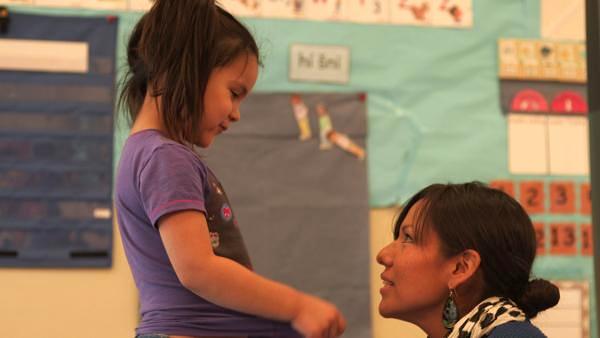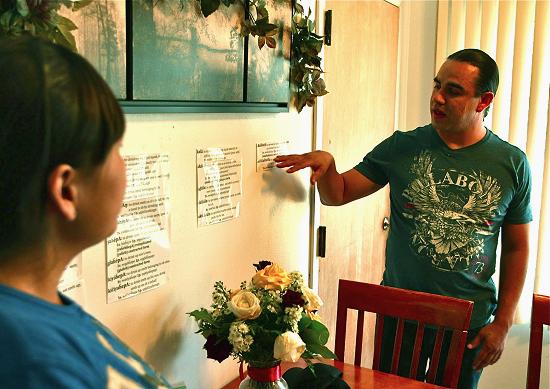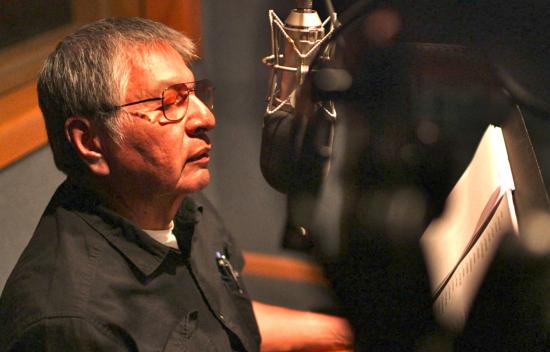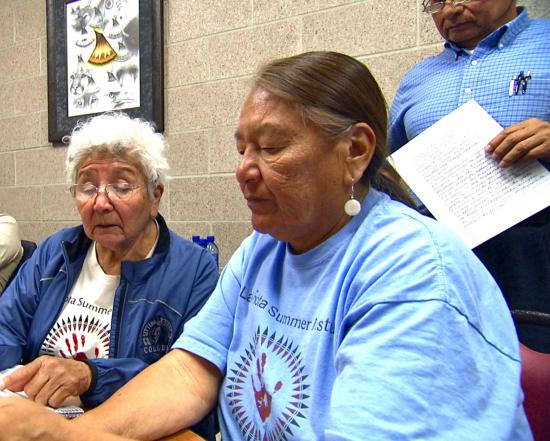 |
Canku Ota
|
 |
|
(Many Paths)
|
||
|
An Online Newsletter
Celebrating Native America
|
||
|
November 2015 - Volume
13 Number 11
|
||
|
|
||
|
'Rising Voices':
New Film A Call To Arms For Lakota Language Revitalization
|
||
|
by Christina Rose -
Indian Country Today Media Network
|
||
|
credits: All photos courtesy
Rising Voices
|
|
"When I speak Lakota, I feel connected to all my relatives in the previous generations. I feel connected to my land. There's nothing to compare it to, the feeling of being Lakota in Lakota country, speaking Lakota." – TipiziwinYoung, Lakota language teacher, Sitting Bull College, Fort Yates, North Dakota, from the film "Rising Voices."
In November, PBS will air "Rising Voices," a new film about the efforts to preserve the Lakota language. The film takes the viewer from hope to despair, from apathy to excitement, and from the past to the present. As tribes across the country face the challenges of language restoration, many will identify with the struggles and efforts highlighted by this film. Apathy towards the language is apparent in the film. In one scene, the stands are packed at Rapid City, South Dakota's Lakota Nation Invitational basketball tournament, but just down the hall, the audience chairs remain empty during the Lakota Language Challenge. As elders wonder how to inspire the youth, JoAllyn Archambault, Standing Rock Sioux Tribe, director of American Indian Programs at the Smithsonian's National Museum of Natural History, hopes the Lakota language won't become an archaic artifact. "So many languages around the world are dying. I truly hope the language survives. But at 72, it's not going to be me that saves it, it's going to be my grandchildren."
In South Dakota and North Dakota, where Lakota is the original language, there are four Lakota immersion programs. Perhaps the biggest surprise is that two of them are run by non-Natives. There is a discussion in the film about whether it is appropriate for non-Natives to be so deeply entrenched in teaching the Lakota language. Young, a Standing Rock tribal member, said she believes, "If these people can come in from other parts of the world and are able to learn my language in a fluent, conversational manner, then I can, too. Our language is learnable." There are three short films within the film, and in one, a game show announcer questions teens about their Native identity and their relationship to their language. Their answers are typical of teens, with some feeling language is extremely important and others feeling language is not important at all. The voice of one elder states, "When I see a Lakota kid who doesn't speak Lakota... I am hurt by the youth not knowing the language." The relationship between language and identity is woven throughout the film and explored against a backdrop of tragic military history and abuse in the boarding schools. When elders in the film recall the intensity of their boarding school experiences, which caused them to abandon their language, a powerful moment of recognition occurs: it will take an equally intense movement to bring the language back. It is no small deal and no small effort.
But not all of the youth in the film ignore the efforts to reclaim their language legacy. At the Red Cloud school, high school students take the language class daily. Lakota language teacher Philomene Lakota, who shares her boarding school experiences, says her students give her hope when they come to class and voluntarily begin speaking the language. Lakota reminds her students that they are in the biggest battle of their life. "They look at me and wonder, what battle? And that's when I tell them you're going to fight this battle by speaking it, and learning it, and using it and spreading it and teaching it. Go home and teach your family. And if you do not do any of that, then you will have lost the battle of the Lakota language." The film ventures into the homes of students and teachers, the young and the elderly, and gives a picture of the variety of efforts made by those who are passionate about retaining what hopefully will never be lost. There are 170,000 Lakota people and only 6,000 Lakota speakers, with an average age of close to 70 years old. The language is at risk. The film makes the connection between social ills on the reservations, loss of culture, and language loss. To make the point, Lakota Summer Institute teacher Ben Black Bear explains, "In English you say, 'A thunderstorm is coming and there's lightening with it.' If we say that in Lakota we say, 'They have returned. They've opened their eyes. They're thundering, they're making noise.' When we have a thunderstorm coming without realizing we think, 'hey, there's thunder beings returning.'"
Kevin Locke, a board member of the Lakota Language Consortium, agrees. "The Lakota language offers a different perspective, a different angle on the world that we live in." "Rising Voices" was produced by Wilhelm Meya, chairman and executive director of Lakota Language Consortium. Meya told ICTMN that there were two main objectives in making the film. "One was to do a film that would inspire Native youth to take up the cause of learning their language. We wanted to communicate to community members, so they would have a model to become language activists themselves. But we also wanted a film that would tell the stories of the language revitalization movement for the general public. Most people in the United States aren't aware that Native languages are endangered. A film like this is a good way to educate them about this crisis. It will also get them emotionally involved in it; to feel what these communities are going through." "It all depends on a youth movement," Locke told ICTMN. "The only way it will move forward is with a youth movement." Locke said it was young people who led the language movement in New Zealand, which has been successful. "And it is happening with Lakota. There is a large group of young people that are committed to obtaining fluency in Lakota, and they are beginning to use it in the home and it is happening in incremental levels."
|
||||||||||
|
|
|
|
||
|
|
||
| Canku Ota is a free Newsletter celebrating Native America, its traditions and accomplishments . We do not provide subscriber or visitor names to anyone. Some articles presented in Canku Ota may contain copyright material. We have received appropriate permissions for republishing any articles. Material appearing here is distributed without profit or monetary gain to those who have expressed an interest. This is in accordance with Title 17 U.S.C. Section 107. | ||
|
Canku Ota is a copyright ©
2000 - 2015 of Vicki Williams Barry and Paul Barry.
|
||
 |
 |
|
|
The "Canku
Ota - A Newsletter Celebrating Native America" web site and
its design is the
|
||
|
Copyright ©
1999 - 2015 of Paul C. Barry.
|
||
|
All Rights Reserved.
|
||




